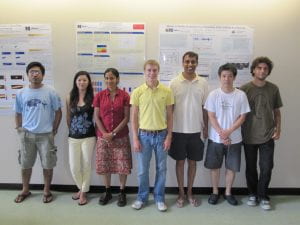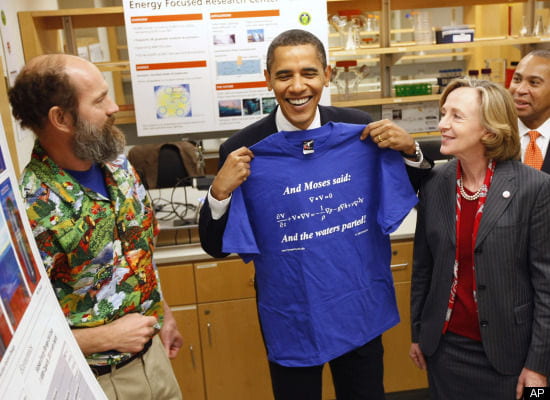Every year Boston University Physics department chooses ONE out of its roughly 100 students for a research performance award. For the academic year 2011-12, this award goes to JASON OLEJARZ, a UMass Dartmouth undergraduate alumni who worked with me on research projects as an undergraduate. Jason has published three articles on his research as a graduate student and more are in the works!
Exploring the upper ocean
Tandon Laboratory at UMass Dartmouth
Author: Amit Tandon (page 2 of 3)
Sanjiv_Tandon_Mahadevan_OMpreprint2012
We study the effect of subgrid-scale (SGS) mixing on the evolution of a zonal, frontal jet initially in thermal-wind balance with a meridional density gradient and forced by downfront surface winds. The horizontal size of the model domain (O (100 km)) is large enough to contain mesoscale eddies while the horizontal grid resolution (\(500\)m) is fine enough to resolve submesoscale eddies. We compare the performance of two subgrid-scale (SGS) models: (i) constant lateral SGS viscosities (1 m^2/s and 5 m^2/s) and an analytically prescribed vertical SGS viscosity; and (ii) an existing variant of the original Smagorinsky SGS model developed for anisotropic grids with large aspect ratios. Our simulations show the subgrid model can influence adversely the dynamics at scales of motion far removed from the grid cutoff scale. In particular, we find the following are insufficiently robust to changes in the subgrid model or the model constant for a given subgrid model: (i) the strength of the inverse and forward cascades; (ii) the efficiency of conversion of available potential energy (APE) to eddy kinetic energy (EKE); and (iii) the zonally-averaged resolved-scale EKE budgets. Among the different simulations, those using a constant lateral SGS viscosity of 5 m^2/s exhibit the weakest inverse and forward cascades, and the most inefficient conversion of APE to EKE. Differences in the zonally-averaged resolved-scale EKE budgets obtained using the two SGS models are minimal within a near-surface layer similar to the traditional Monin-Obukhov (MO) layer. Below this MO-like layer, however, the differences are significant as simulations with a constant lateral SGS viscosity and a background SGS vertical viscosity fail to reproduce a realistic balance between the various terms in the EKE budget. A lateral viscosity of 1 m^2/s predicts the production of EKE is balanced solely by pressure transport with negligible SGS destruction, whereas recent experimental studies show enhanced destruction near fronts. For a constant lateral viscosity of 5 m^2/s the magnitude of the dominant production term is an order of magnitude smaller than scaling estimates in the literature due to the poor conversion of APE to EKE. The EKE budgets obtained using the anisotropic Smagorinsky model (ASM) show production of EKE is balanced by a combination of pressure transport and SGS destruction. The magnitude of the dominant production term is consistent with existing scaling estimates in the literature.
This collection of articles from an ONR sponsored workshop in 2009 is interesting. Read on..
“When someone tells you that ‘Oh, math is not really my thing,’ respond back, ‘and working at McDonald’s isn’t mine.’”
Danny Crichton, Stanford University Student
“We had more sports-exercise majors graduate than electrical engineering graduates last year. If you want to become the massage capital of the world, you’re well on your way.”
Jeff Immelt, CEO, General Electric Co.
“. . . of the seventy finalists in an NSA (National Security Agency)-backed computer coding contest, twenty were from China, ten from Russia and two from the USA.”
Patrick Thibodeau, Computerworld
“The 19th century belonged to England, the 20th century belonged to the United States, and the 21st century belongs to China. Invest accordingly.”
Warren Buffett
This picture was taken just after Eric Holmes’s successful M.S. defense. Congratulations, Eric!
Our research group uses the Process Studies Ocean Model originally crafted by Prof. Amala Mahadevan at Boston University and now in use for multiple process studies at many institutions.
Graduate students Xianquin Yao and Eric Holmes at UMass Dartmouth are now beginning to investigate whether we can get a speedup of this model by harnessing the parallelizing potential of GPUs. Rakesh Ginjupalli and Prof. Gaurav Khanna have used CUDA Fortran for Astrophysical Black hole simulations, and we would be getting their advice and help on PSOM optimizations. The computational power for this work will be enabled by our participation on the recent MRI granted to Prof. Bob Fisher and colleagues at UMass Dartmouth by the National Science Founfdation; see this link.
Graduate students Sudip Majumder and Eric Holmes presented their research work in poster format at the Ocean Sciences Meeting 2010.
It is an enjoyable experience to meet many scientists from around the World, and to share one’s research results with them.
From a “reference frame” article by Michael S. Turner, in the September 2009 issue of Physics Today:
“I have always liked the metaphor of a child watching chess to convey the mission of physics—namely, that we carefully observe Nature to discover her underlying rules. Of course, knowing the rules doesn’t mean you understand the game. That is especially true in complex systems, whether turbulent fluids or living organisms. Understanding complexity and the emergence of large-scale behavior remains a big challenge. ”
This is very true of many pheonmena in Physical Oceanography and Climate Physics.
Another quote from the same article:
“There is an important unity in how physicists approach problems. Physicists use rigorous and quantitative methods; they search for underlying principles and fundamental laws; they begin with simple models and add complexity; and they rely on reductionism and innovative instrumentation. While the name of the activity remains the same, the foci change—so much so that the only robust definition is that physics is what physicists do. Physics has evolved from earthly and celestial mechanics 400 years ago to include electricity, magnetism, and statistical mechanics in the 18th and 19th centuries; and today it encompasses materials, atoms, nuclei, elementary particles, the cosmos, and a growing number of aspects of biology. Its practitioners have invented new tools—mathematical, conceptual, and instrumental—to get at the most urgent questions of their day.”
The full article is at the Physics Today Website at http://ptonline.aip.org/journals/doc/PHTOAD-ft/vol_62/iss_9/8_1.shtml
Graduate Student Eric Holmes has arrived in Tokyo to participate in a scientific experiment. He joins a group of 17 other scientists, led by the Chief Scientist Prof. Takeyoshi Nagai (a post doctoral alumnus of our group) who will be making physical, biological and chemical measurements across the Kuroshio Front. The host institution is the Tokyo University of Marine Science and Technology.
Eric Holmes is now onboard R/V Natsushima with other scientists from Tokyo University of Marine Science and Technology, MIT, and the Woods Hole Oceanographic Institution to make measurements across the Kuroshio Front and fast moving Kuroshio current!
The main objectives of this scientific cruise are to elucidate whether the small scale turbulent dissipation in response to the mesoscale forcing, such as frontogenesis, is ubiquitous and intrinsic feature of the fronts, and to investigate the magnitude and spatial spread of dissipation sites in three-dimensional space near the Kuroshio Front, to investigate horizontal scales of distribution of nitrate across the front, and to investigate the submesoscale contrast in species compositions of zooplankton and phytoplankton across the Kuroshio Front.
The scientific cruise will last from Oct 17th to October 24th 2009 in which five detailed transects across the Kuroshio Front are planned.
© 2025 Exploring the upper ocean
Theme by Anders Noren — Up ↑




Recent Comments